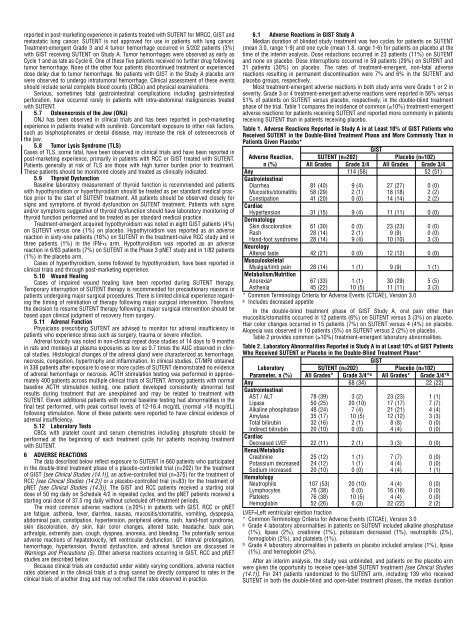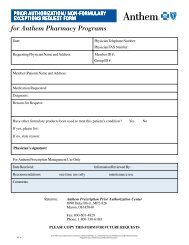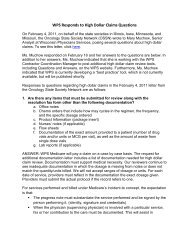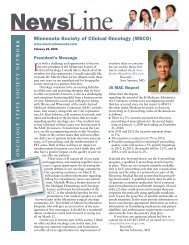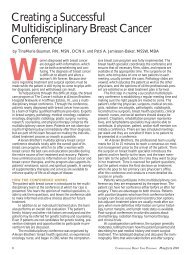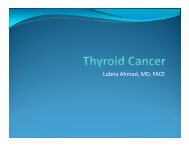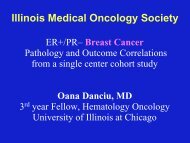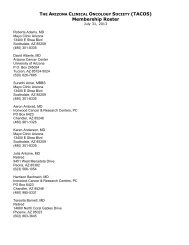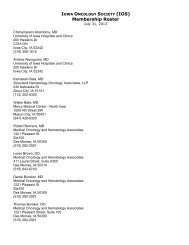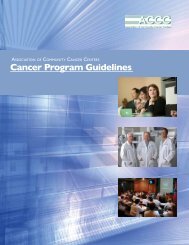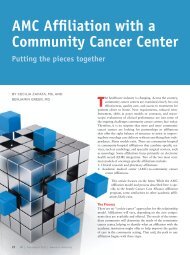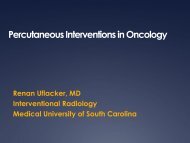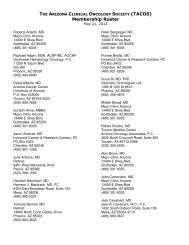2013 Patient Assistance and Reimbursement Guide - Association of ...
2013 Patient Assistance and Reimbursement Guide - Association of ...
2013 Patient Assistance and Reimbursement Guide - Association of ...
You also want an ePaper? Increase the reach of your titles
YUMPU automatically turns print PDFs into web optimized ePapers that Google loves.
eported in post-marketing experience in patients treated with SUTENT for MRCC, GIST <strong>and</strong><br />
metastatic lung cancer. SUTENT is not approved for use in patients with lung cancer.<br />
Treatment-emergent Grade 3 <strong>and</strong> 4 tumor hemorrhage occurred in 5/202 patients (3%)<br />
with GIST receiving SUTENT on Study A. Tumor hemorrhages were observed as early as<br />
Cycle 1 <strong>and</strong> as late as Cycle 6. One <strong>of</strong> these five patients received no further drug following<br />
tumor hemorrhage. None <strong>of</strong> the other four patients discontinued treatment or experienced<br />
dose delay due to tumor hemorrhage. No patients with GIST in the Study A placebo arm<br />
were observed to undergo intratumoral hemorrhage. Clinical assessment <strong>of</strong> these events<br />
should include serial complete blood counts (CBCs) <strong>and</strong> physical examinations.<br />
Serious, sometimes fatal gastrointestinal complications including gastrointestinal<br />
perforation, have occurred rarely in patients with intra-abdominal malignancies treated<br />
with SUTENT.<br />
5.7 Osteonecrosis <strong>of</strong> the Jaw (ONJ)<br />
ONJ has been observed in clinical trials <strong>and</strong> has been reported in post-marketing<br />
experience in patients treated with sunitinib. Concomitant exposure to other risk factors,<br />
such as bisphosphonates or dental disease, may increase the risk <strong>of</strong> osteonecrosis <strong>of</strong><br />
the jaw.<br />
5.8 Tumor Lysis Syndrome (TLS)<br />
Cases <strong>of</strong> TLS, some fatal, have been observed in clinical trials <strong>and</strong> have been reported in<br />
post-marketing experience, primarily in patients with RCC or GIST treated with SUTENT.<br />
<strong>Patient</strong>s generally at risk <strong>of</strong> TLS are those with high tumor burden prior to treatment.<br />
These patients should be monitored closely <strong>and</strong> treated as clinically indicated.<br />
5.9 Thyroid Dysfunction<br />
Baseline laboratory measurement <strong>of</strong> thyroid function is recommended <strong>and</strong> patients<br />
with hypothyroidism or hyperthyroidism should be treated as per st<strong>and</strong>ard medical practice<br />
prior to the start <strong>of</strong> SUTENT treatment. All patients should be observed closely for<br />
signs <strong>and</strong> symptoms <strong>of</strong> thyroid dysfunction on SUTENT treatment. <strong>Patient</strong>s with signs<br />
<strong>and</strong>/or symptoms suggestive <strong>of</strong> thyroid dysfunction should have laboratory monitoring <strong>of</strong><br />
thyroid function performed <strong>and</strong> be treated as per st<strong>and</strong>ard medical practice.<br />
Treatment-emergent acquired hypothyroidism was noted in eight GIST patients (4%)<br />
on SUTENT versus one (1%) on placebo. Hypothyroidism was reported as an adverse<br />
reaction in sixty-one patients (16%) on SUTENT in the treatment-naïve RCC study <strong>and</strong> in<br />
three patients (1%) in the IFN-a arm. Hypothyroidism was reported as an adverse<br />
reaction in 6/83 patients (7%) on SUTENT in the Phase 3 pNET study <strong>and</strong> in 1/82 patients<br />
(1%) in the placebo arm.<br />
Cases <strong>of</strong> hyperthyroidism, some followed by hypothyroidism, have been reported in<br />
clinical trials <strong>and</strong> through post-marketing experience.<br />
5.10 Wound Healing<br />
Cases <strong>of</strong> impaired wound healing have been reported during SUTENT therapy.<br />
Temporary interruption <strong>of</strong> SUTENT therapy is recommended for precautionary reasons in<br />
patients undergoing major surgical procedures. There is limited clinical experience regarding<br />
the timing <strong>of</strong> reinitiation <strong>of</strong> therapy following major surgical intervention. Therefore,<br />
the decision to resume SUTENT therapy following a major surgical intervention should be<br />
based upon clinical judgment <strong>of</strong> recovery from surgery.<br />
5.11 Adrenal Function<br />
Physicians prescribing SUTENT are advised to monitor for adrenal insufficiency in<br />
patients who experience stress such as surgery, trauma or severe infection.<br />
Adrenal toxicity was noted in non-clinical repeat dose studies <strong>of</strong> 14 days to 9 months<br />
in rats <strong>and</strong> monkeys at plasma exposures as low as 0.7 times the AUC observed in clinical<br />
studies. Histological changes <strong>of</strong> the adrenal gl<strong>and</strong> were characterized as hemorrhage,<br />
necrosis, congestion, hypertrophy <strong>and</strong> inflammation. In clinical studies, CT/MRI obtained<br />
in 336 patients after exposure to one or more cycles <strong>of</strong> SUTENT demonstrated no evidence<br />
<strong>of</strong> adrenal hemorrhage or necrosis. ACTH stimulation testing was performed in approximately<br />
400 patients across multiple clinical trials <strong>of</strong> SUTENT. Among patients with normal<br />
baseline ACTH stimulation testing, one patient developed consistently abnormal test<br />
results during treatment that are unexplained <strong>and</strong> may be related to treatment with<br />
SUTENT. Eleven additional patients with normal baseline testing had abnormalities in the<br />
final test performed, with peak cortisol levels <strong>of</strong> 12-16.4 mcg/dL (normal >18 mcg/dL)<br />
following stimulation. None <strong>of</strong> these patients were reported to have clinical evidence <strong>of</strong><br />
adrenal insufficiency.<br />
5.12 Laboratory Tests<br />
CBCs with platelet count <strong>and</strong> serum chemistries including phosphate should be<br />
performed at the beginning <strong>of</strong> each treatment cycle for patients receiving treatment<br />
with SUTENT.<br />
6 ADVERSE REACTIONS<br />
The data described below reflect exposure to SUTENT in 660 patients who participated<br />
in the double-blind treatment phase <strong>of</strong> a placebo-controlled trial (n=202) for the treatment<br />
<strong>of</strong> GIST [see Clinical Studies (14.1)], an active-controlled trial (n=375) for the treatment <strong>of</strong><br />
RCC [see Clinical Studies (14.2)] or a placebo-controlled trial (n=83) for the treatment <strong>of</strong><br />
pNET [see Clinical Studies (14.3)]. The GIST <strong>and</strong> RCC patients received a starting oral<br />
dose <strong>of</strong> 50 mg daily on Schedule 4/2 in repeated cycles, <strong>and</strong> the pNET patients received a<br />
starting oral dose <strong>of</strong> 37.5 mg daily without scheduled <strong>of</strong>f-treatment periods.<br />
The most common adverse reactions (≥20%) in patients with GIST, RCC or pNET<br />
are fatigue, asthenia, fever, diarrhea, nausea, mucositis/stomatitis, vomiting, dyspepsia,<br />
abdominal pain, constipation, hypertension, peripheral edema, rash, h<strong>and</strong>-foot syndrome,<br />
skin discoloration, dry skin, hair color changes, altered taste, headache, back pain,<br />
arthralgia, extremity pain, cough, dyspnea, anorexia, <strong>and</strong> bleeding. The potentially serious<br />
adverse reactions <strong>of</strong> hepatotoxicity, left ventricular dysfunction, QT interval prolongation,<br />
hemorrhage, hypertension, thyroid dysfunction, <strong>and</strong> adrenal function are discussed in<br />
Warnings <strong>and</strong> Precautions (5). Other adverse reactions occurring in GIST, RCC <strong>and</strong> pNET<br />
studies are described below.<br />
Because clinical trials are conducted under widely varying conditions, adverse reaction<br />
rates observed in the clinical trials <strong>of</strong> a drug cannot be directly compared to rates in the<br />
clinical trials <strong>of</strong> another drug <strong>and</strong> may not reflect the rates observed in practice.<br />
6.1 Adverse Reactions in GIST Study A<br />
Median duration <strong>of</strong> blinded study treatment was two cycles for patients on SUTENT<br />
(mean 3.0, range 1-9) <strong>and</strong> one cycle (mean 1.8, range 1-6) for patients on placebo at the<br />
time <strong>of</strong> the interim analysis. Dose reductions occurred in 23 patients (11%) on SUTENT<br />
<strong>and</strong> none on placebo. Dose interruptions occurred in 59 patients (29%) on SUTENT <strong>and</strong><br />
31 patients (30%) on placebo. The rates <strong>of</strong> treatment-emergent, non-fatal adverse<br />
reactions resulting in permanent discontinuation were 7% <strong>and</strong> 6% in the SUTENT <strong>and</strong><br />
placebo groups, respectively.<br />
Most treatment-emergent adverse reactions in both study arms were Grade 1 or 2 in<br />
severity. Grade 3 or 4 treatment-emergent adverse reactions were reported in 56% versus<br />
51% <strong>of</strong> patients on SUTENT versus placebo, respectively, in the double-blind treatment<br />
phase <strong>of</strong> the trial. Table 1 compares the incidence <strong>of</strong> common (≥10%) treatment-emergent<br />
adverse reactions for patients receiving SUTENT <strong>and</strong> reported more commonly in patients<br />
receiving SUTENT than in patients receiving placebo.<br />
Table 1. Adverse Reactions Reported in Study A in at Least 10% <strong>of</strong> GIST <strong>Patient</strong>s who<br />
Received SUTENT in the Double-Blind Treatment Phase <strong>and</strong> More Commonly Than in<br />
<strong>Patient</strong>s Given Placebo*<br />
GIST<br />
Adverse Reaction, SUTENT (n=202) Placebo (n=102)<br />
n (%) All Grades Grade 3/4 All Grades Grade 3/4<br />
Any 114 (56) 52 (51)<br />
Gastrointestinal<br />
Diarrhea 81 (40) 9 (4) 27 (27) 0 (0)<br />
Mucositis/stomatitis 58 (29) 2 (1) 18 (18) 2 (2)<br />
Constipation 41 (20) 0 (0) 14 (14) 2 (2)<br />
Cardiac<br />
Hypertension 31 (15) 9 (4) 11 (11) 0 (0)<br />
Dermatology<br />
Skin discoloration 61 (30) 0 (0) 23 (23) 0 (0)<br />
Rash 28 (14) 2 (1) 9 (9) 0 (0)<br />
H<strong>and</strong>-foot syndrome 28 (14) 9 (4) 10 (10) 3 (3)<br />
Neurology<br />
Altered taste 42 (21) 0 (0) 12 (12) 0 (0)<br />
Musculoskeletal<br />
Myalgia/limb pain 28 (14) 1 (1) 9 (9) 1 (1)<br />
Metabolism/Nutrition<br />
Anorexia a 67 (33) 1 (1) 30 (29) 5 (5)<br />
Asthenia 45 (22) 10 (5) 11 (11) 3 (3)<br />
* Common Terminology Criteria for Adverse Events (CTCAE), Version 3.0<br />
a Includes decreased appetite<br />
In the double-blind treatment phase <strong>of</strong> GIST Study A, oral pain other than<br />
mucositis/stomatitis occurred in 12 patients (6%) on SUTENT versus 3 (3%) on placebo.<br />
Hair color changes occurred in 15 patients (7%) on SUTENT versus 4 (4%) on placebo.<br />
Alopecia was observed in 10 patients (5%) on SUTENT versus 2 (2%) on placebo.<br />
Table 2 provides common (≥10%) treatment-emergent laboratory abnormalities.<br />
Table 2. Laboratory Abnormalities Reported in Study A in at Least 10% <strong>of</strong> GIST <strong>Patient</strong>s<br />
Who Received SUTENT or Placebo in the Double-Blind Treatment Phase*<br />
GIST<br />
Laboratory SUTENT (n=202) Placebo (n=102)<br />
Parameter, n (%) All Grades* Grade 3/4* a All Grades* Grade 3/4* b<br />
Any 68 (34) 22 (22)<br />
Gastrointestinal<br />
AST / ALT 78 (39) 3 (2) 23 (23) 1 (1)<br />
Lipase 50 (25) 20 (10) 17 (17) 7 (7)<br />
Alkaline phosphatase 48 (24) 7 (4) 21 (21) 4 (4)<br />
Amylase 35 (17) 10 (5) 12 (12) 3 (3)<br />
Total bilirubin 32 (16) 2 (1) 8 (8) 0 (0)<br />
Indirect bilirubin 20 (10) 0 (0) 4 (4) 0 (0)<br />
Cardiac<br />
Decreased LVEF 22 (11) 2 (1) 3 (3) 0 (0)<br />
Renal/Metabolic<br />
Creatinine 25 (12) 1 (1) 7 (7) 0 (0)<br />
Potassium decreased 24 (12) 1 (1) 4 (4) 0 (0)<br />
Sodium increased 20 (10) 0 (0) 4 (4) 1 (1)<br />
Hematology<br />
Neutrophils 107 (53) 20 (10) 4 (4) 0 (0)<br />
Lymphocytes 76 (38) 0 (0) 16 (16) 0 (0)<br />
Platelets 76 (38) 10 (5) 4 (4) 0 (0)<br />
Hemoglobin 52 (26) 6 (3) 22 (22) 2 (2)<br />
LVEF=Left ventricular ejection fraction<br />
* Common Terminology Criteria for Adverse Events (CTCAE), Version 3.0<br />
a Grade 4 laboratory abnormalities in patients on SUTENT included alkaline phosphatase<br />
(1%), lipase (2%), creatinine (1%), potassium decreased (1%), neutrophils (2%),<br />
hemoglobin (2%), <strong>and</strong> platelets (1%).<br />
b Grade 4 laboratory abnormalities in patients on placebo included amylase (1%), lipase<br />
(1%), <strong>and</strong> hemoglobin (2%).<br />
After an interim analysis, the study was unblinded, <strong>and</strong> patients on the placebo arm<br />
were given the opportunity to receive open-label SUTENT treatment [see Clinical Studies<br />
(14.1)]. For 241 patients r<strong>and</strong>omized to the SUTENT arm, including 139 who received<br />
SUTENT in both the double-blind <strong>and</strong> open-label treatment phases, the median duration


